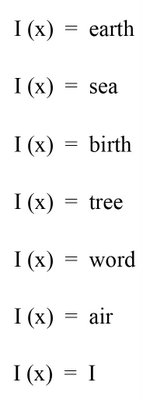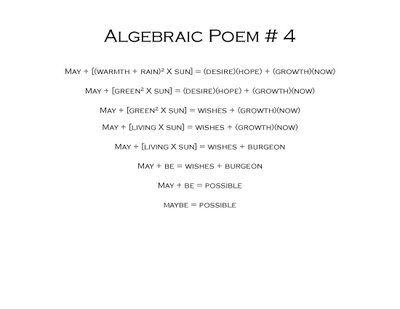‘ Visual Art Aesthetic’ is the aesthetic that concerns itself primarily with the beauty or horror expressed in direct sensory experience, whereas the ‘ Mathematics Aesthetic’ concerns itself with the beauty in the structures of logic and thinking.
‘Mathematic Aesthetic’ is the aesthetic that concerns itself with the beauty in the structures of logic and thinking, whereas the ‘Artistic aesthetic’ is concerned primarily with the beauty expressed in direct sensory experience.
'Mathematical Conceptual Art’ This form of Art focuses on the Math aesthetic and re-contextualizes it as Art personally I feel conceptual art is not art however, it is aesthetic but. That does not necessarily mean that Math is art. The main difference between ‘Mathematical Conceptual Art’ and ‘Visual Mathematics’ is that in the former the artist presents their the work as Math, where as in the later they display the mathematical object as Art. In both types, they display the object in the context of an Artistic space. A good example of “Mathematical Conceptual Art’ would be the work in the late 1960’s of
Benar Venet in which he would study Math and Physics and present what he had learned purely for the aesthetic of the topic involved. There are many works of
Sol Lewitt that could be considered “Mathematical Conceptual Art’ as well. A contemporary Artist who I would consider a ‘Mathematical Conceptual Artist’ is the British artist
Justin Mullins although he does some work that could be considered as ‘Mathematical Visual Poetry’. The main difference between Mathematical Conceptual Art and Mathematical Poetry is that the Conceptual Art movement as a whole was not concerned with the intention of metaphor in any form and Mathematical Poetry relies mostly on metaphor to make its connection to poetry in general
‘Mathematic Constructivism’ Is one of the most popular forms of Mathematically related Art. It is a term I will use to sum up a conceptual thread that started with the Russian
constructivists and ended up in the modern movement of visual mathematics. The former started in the political and social upheaval of the 1920’s with the emergence of Artists such as
Naum Gabo,
Vladimir Tatlin and ended up in the latter movement with mathematicians such as
Donald Coxeter who felt their mathematical work is a form of Art. Donald Coxeter imparted much mathematical assistance to M C Escher.
The conceptual idea of Cubism pushed visual Art into a process of abstraction whereby the artist removes unnecessary visual layers of an object in order to point to a metaphysical idea of the object. Art Constructivism moved to push the methodology of abstract Art more and more abstract to the point of the object being something not found in nature -- a “construction”. If we push this idea further we end up in realm of ‘Visual Mathematics’ where the object of Art is pure logic, a reflection of the logical structures of language in our mind. Today ‘Mathematical Constructivist’ work has moved more toward ‘Visual Mathematics’ and can be seen in the work of
Max Bill,
Helaman Ferguson,
Rinus Roelofs,
Robert Fathauer,
Brent Collins and many others.
‘Mathematical Poetry’ – Mathematical Poetry is a umbrella term that covers any poetic expression involving Mathematics. An initial list of categories is as follows: Equational Poetry, Mathematical Visual Poetry, Visual Mathematical Poetry, Mathematics Poetry and Number Poetry
‘Equational Poetry’ – This is literally performing mathematical operations on concepts whether they are words or images. A good example would be my page at the following link:
Mathematical Poetry
'Visual Mathematical Poetry' -- This is a mathematical poem where the elements in that poem are visual objects. The difference between mathematical poetry and visual mathematical poetry is that the former uses words and the later uses images. Visual mathematical poetry is more similar to mathematical poetry than it is to mathematical visual poetry. However, one could create a poem that has aspects of all three of these types. For an example check out
"Americana Mathematics"
‘Mathematical Visual Poetry’ – This is more difficult to define because of the vast areas and the many competing definitions of visual poetry. However, I consider mathematical operations on text as well as mathematical textual information composed for aesthetic purposes to be ‘Mathematical Visual Poetry’ Also words, text or textual elements mixed with mathematical symbols or formulae that are not performing mathematical operations on the word meanings. Although
Karl Kempton has worked in many categories, I feel the following is a good example of
‘Mathematical visual poetry’: Another good example is Marko Niemi’s fractal poem described in the following link:
Midwinter nights dream Scott Helmes was one of the first visual poets that moved into mathematical motifs.
Bob Gruman has probably been the most prolific in this catagory.
‘Mathematics Poetry’ -- This poetry is what I would call traditional language poetry about or inspired by or uses mathematical imagery. I also would consider this catagory to include language poetry that has an interaction of numbers with words. There are numerous examples all over the web but the most popular from google's perspective seems to be
Marion Cohen: other sources would be
JoAnne Growney and
Katherine Stange:
'Polyaesthetics' is a word used in relation to aesthetic works which incorporate many diverse aesthetics. This is not limited to but includes the aesthetics of Mathematics, Art, Music, Science, Religion etc.
'Visual Mathematics' Is one of the most popular forms of mathematically related art. It sometimes has been called “Concrete Art” This is a form of Art that focuses on the Math aesthetic and re-contextualizes it as Art. The main difference between ‘Mathematical Conceptual Art’ and ‘Visual Mathematics’ is that in the former the artist presents his/her personal/emotional relationship with the aesthetic of Mathematics where as in the later the display is less personal and more cerebral. In both types the object of that presentation is displayed as a form of Art. The hero of visual mathematics is
M C Escher whose work is so strong anything that resembles it looks cliché. Fortunately there are other arenas in Visual mathematics. A good example of contemporary Visual Mathematics is found in the work of
George Hart,
Paul Gailiunas,
Carlo Sequin,
Robert Krawczyk,
Michael Sussna and many others. This type of work is primary interested in visualizing mathematic structures. These structures could be anything from computer algorithms not limited to fractal Art or polytopes to hand drawings, plastic sculpture or origami.
*Disclaimer: These are the views of Kaz Maslanka and are a rough attempt at trying to put mathematical poetry in context with most of the mathematical influences in visual Art of the last 100 years






















































